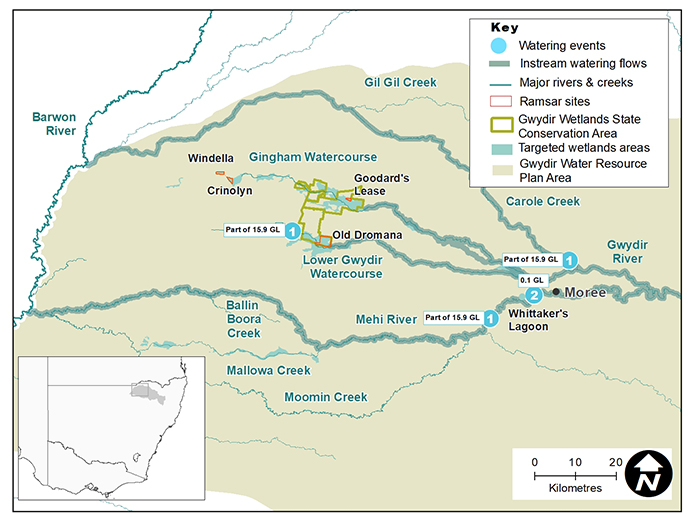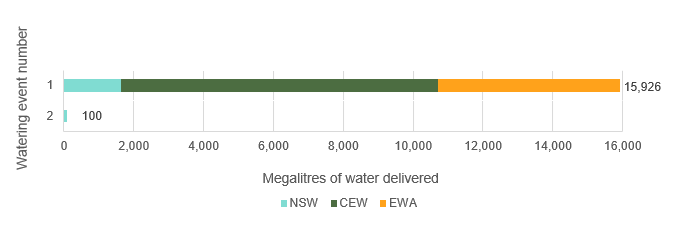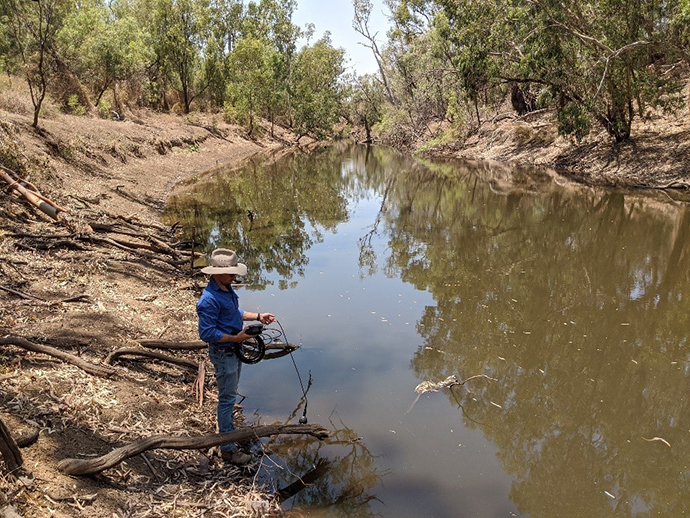The Gwydir valley catchment extends from the Northern Tablelands to the Northern Plains, where it joins the Barwon River, covering an area of 26,596 square kilometres. The Gwydir River system and its wetlands are located on a semi-arid floodplain, in a relatively low rainfall zone. This influences decision-making around water for the environment.
Since the summer of 2016, the Gwydir catchment has experienced an extended hot and dry period, with limited rainfall and low natural flows. At the beginning of this water year, the catchment was in a very dry state. These conditions prevailed throughout spring and summer 2019. Rainfall and river flows finally returned to the catchment system in February 2020.
Protecting key assets
The focus of water managers in 2019–20, with an expected very dry resource availability scenario, as identified in the Gwydir Catchment Annual Environmental Watering Priorities 2019–20, was on protecting key water-dependent assets, such as native fish communities. Water for the environment was used to support the resilience of local rivers to ensure they were ready to respond when rain and river flows returned to the catchment. This approach protected fish communities in priority river reaches in the Carole Creek, Mehi and Gwydir rivers from complete drying. In early 2020 much wetter than expected conditions enabled environmental deliveries to the Gwydir wetlands.
A conservative planning approach taken over preceding seasons meant there were remaining reserves of water for the environment at the beginning of the 2019–20 water year.
Significant water for the environment outcomes included deliveries made to keep fish communities alive in these river reaches in the system, commencing in October 2019 through to January 2020.
A small delivery was made to Whittaker’s Lagoon, on the Mehi River floodplain, that served as key habitat and resources for water-dependent local native animals, during the extended dry period.
When rains and river flows returned to the system in early 2020, water managers delivered water for the environment in combination with natural flows into the downstream Gwydir Wetlands, inundating about 3500 hectares of core wetland habitats and communities.

Gwydir catchment area map
Watering aims
In the 2019–20 year, no rainfall or natural river flows occurred in the Gwydir catchment until February 2020. However, reserves of water for the environment were available to preserve targeted water-reliant ecological communities and support them through this dry phase.
The Department of Planning, Industry and Environment – Environment, Energy and Science’s Water for the Environment Team worked with the Commonwealth Environmental Water Holder to manage 20 gigalitres of water flows to:
- support and preserve the fish communities in priority aquatic environments
- provide water to wetland vegetation and water-dependent fauna in the Gwydir Wetlands
- provide a small delivery to the off-stream Whittaker’s Lagoon, on the Mehi Floodplain.
Annual planning of water for the environment takes a flexible and responsive approach. This approach responds to natural cues and ecological water needs across the range of systems and climatic conditions. Annual planning has a rolling 3-year planning cycle and considerations include carrying over enough volume to support water-dependent communities into the longer term.
The watering aims identified in the Gwydir Catchment Annual Environmental Watering Priorities 2019–20 were achieved as proposed under the very dry conditions. The wetter conditions experienced in early 2020 allowed a water delivery to the Gwydir wetland system taking advantage of the natural flows.
Water delivery
This bar chart and table provide a summary of 16,026 megalitres of environmental water delivered in the Gwydir catchment during the 2019–20 watering year. Volumes are indicative only. Watering event numbers in the bar chart and table relate to location numbers marked on the map.

Bar chart showing water delivery to the Gwydir catchment in the 2019–20 water year
Notes: NSW = NSW licensed environmental water; CEW = Commonwealth licensed environmental water; EWA = Environmental water allowance accrued under the Water Sharing Plan for the Gwydir Regulated River Water Source 2016.
| Watering event number | Location | Outcomes | Start date | Finish date |
|---|---|---|---|---|
| 1 | Dry river priority reaches | Native fish | 23 Oct 2019 | 16 Feb 2020 |
| 2 | Whittaker’s Lagoon | Waterbirds | 14 Feb 2020 | 14 Feb 2020 |
Outcomes
During the 2019–20 water year, water for the environment was released into priority river reaches, Whittaker’s Lagoon and Gwydir Wetlands systems.
Protecting pools in priority river reaches
Four separate deliveries of water for the environment, totalling 15.9 gigalitres, were made into priority pools and river reaches of the Carole Creek, Mehi River and main Gwydir River, that had ceased to flow from October 2019 to January 2020.
The intent of these releases was to maintain water quality and water levels in pools to enable fish to move between pools and help reduce the risk of fish kills.
Whittaker’s Lagoon
A 100-megalitre delivery of water for the environment was delivered into Whittaker’s Lagoon, located on the Mehi floodplain, taking advantage of a priority delivery made into the Mehi River for fish survival, through the neighbouring Moreton Cotton Farms infrastructure.
The ongoing restoration program of this lagoon has achieved positive outcomes through the drowning of exotic weeds, fostering native wetland plant growth and attracting bird life.
Gwydir Wetlands systems
In early 2020, a total of 3.4 gigalitres of water was delivered to the wetlands of the Lower Gwydir and Gingham watercourses. This watering took advantage of natural river flows due to rains returning to the catchment and inundating 3500 hectares in the Gingham and Big Leather (Lower Gwydir) watercourse wetlands. Surveys indicated good growth of flow-dependent vegetation, provision of habitat for many waterbird species and strong recruitment of frog species.
These outcomes achieved the key planned actions proposed for the 2019–20 water year with wetter conditions in early 2020 enabling additional environmental gains.
Case study
Connecting refuge pools and improving water quality to support species survival was the focus of managed watering events in the Gwydir catchment in 2019–20.
Four separate events saw a total of 15.9 gigalitres of water for the environment delivered into the Gwydir River, Mehi River and Carole Creek. These reaches had ceased to flow, with flows stopping in some of the lower areas for close to 100 days.
In consultation with the Gwydir Environmental Water Advisory Group, the Department of Planning, Industry and Environment began the first water delivery into the priority reaches, downstream of Tareelaroi Weir. This approach had proven effective in the past without water quality issues. However, this season followed an extreme and extended dry period, which was outside previous experiences.
During the early Mehi River flow, poor water quality affected aquatic life. In response, several actions were implemented:
- continual field surveys and water quality testing by NSW regional- and Commonwealth-funded project staff
- increased delivery flow rate from the upstream Mehi River Regulator, to help dilute poorer water quality
- manipulation of instream weirs and gates to assist with water mixing when the flow arrived
- pumping of 100 megalitres out of the front of the flow via a local irrigation system
- diversion of the first 228 megalitres of the flow, into a dry watercourse to protect the downstream weir pool from water quality issues.
This event highlighted that of the 3 priority river systems in the Gwydir, the Mehi River has peculiarities that make it more susceptible to poor water quality impacts when restarted.

Water monitoring on the banks of the Mehi River.